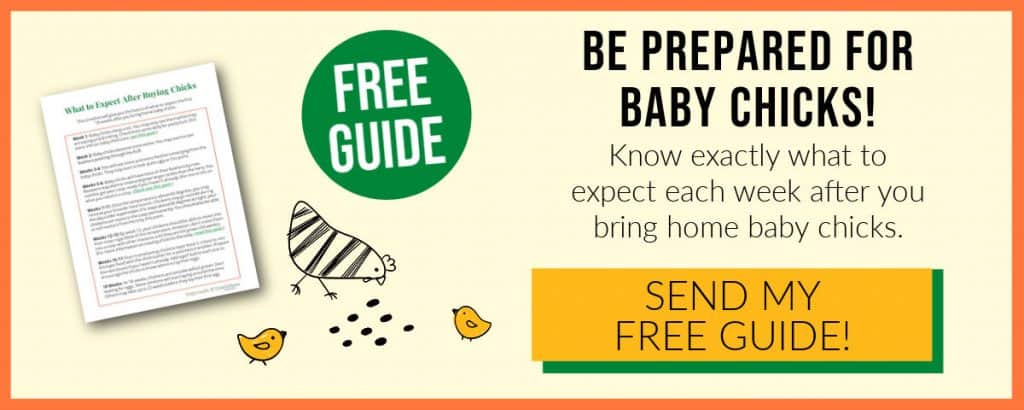When to Transfer From Chick Feed to Chicken Feed
Your baby chicks are growing bigger every day. They are starting to look like adult chickens. You've moved them from the brooder to the coop. But when is the right time to switch chickens to layer feed? And what kind of feed should you choose? Learn how to transition your chickens to adult feed with this simple process to ensure your chickens remain healthy and happy.

(Please note that some of the links in this article may be affiliate links and I may receive a small commission if you purchase something through a link. It will not change your cost. As an Amazon Associate, I earn from qualifying purchases. For more information, check out my disclosures page.)
What Should I Feed My Chickens?
Before we talk about when to make the transition to layer feed, let's first discuss WHAT to feed your chickens when you do make the switch.
When choosing feed to give to your laying hens, be sure to choose layer feed, not broiler feed. Broiler feed is for meat birds and is designed to put weight on the chickens quickly. It contains too much protein and not enough calcium for laying hens. Using broiler feed can lead to all kinds of health problems for laying hens and roosters in your flock.
Your layer feed should contain 16% protein for optimal health. Most premium brands of chicken feed for laying hens contains the appropriate amount of protein and also contains other vital nutrients your chickens need such as Vitamin A, D, and E.
Pellets vs. Crumbles
So now that you know to choose layer feed, you should be aware that it comes in two forms – pellets and crumbles. Crumbles are small pieces of food that are similar in size to what chick starter looks like.
Pellets, on the other hand, are basically compressed chicken feed in the shape of a pellet. I prefer pellets as they tend to be less wasteful since the chickens will usually eat it off the floor of the coop if they knock it out of the feeder. However, this is a personal decision and there isn't a right or wrong choice. Just pick one and stick with it.

Fermented Food
Another alternative is to ferment your chicken feed. You can ferment pellets or crumbles. Fermented food is typically more nutritious, but more work for the chicken keeper. You soak the feed to release nutrients that make it easier for your chickens to digest. (This is similar to how a sourdough starter works.) Fermenting your feed also tends to be cheaper because your flock will eat less. For more information on fermenting your chicken feed, see this post from The Cape Coop.
What Is Grit & Should I Be Feeding It to My Chickens?
Chickens also need grit to digest their food. Purchased grit is basically small crushed rocks or stones that a chicken eats. The grit passes to the chicken's gizzard where it grinds up the food.
If your chickens eat only commercial layer feed (no table scraps or scratch) there is probably no need for grit. Your birds can usually digest commercial feed without it. However, if you do feed your chickens table scraps or your chickens free-range, you should offer grit.
While chickens that free-range will get some grit on their own, to ensure they have plenty it is wise to offer it free choice to your chickens. Have a separate container with grit in it to ensure your birds have access to it at all times. Do not mix it with their feed. They may eat too much grit and not enough food.

How to Switch Chickens to Layer Feed
Now that you know WHAT to feed your chickens, you may be wondering HOW to go about switching chickens to layer feed.
Transitioning young chickens to layer feed is best done as a process. If you abruptly change feed on your flock, it can cause gastric upset and diarrhea.
It is easiest if you allow a two-week span to switch your pullets to the layer feed. Start by mixing a small amount of layer feed in with their normal food. Gradually increase the amount of layer food and decrease the amount of chick starter/grower.
Many people try to switch the chickens too early. The ideal time to make the change is just before they start laying eggs. At around 16 weeks, I start mixing a small amount of layer feed in with the chick starter, gradually increasing the amount of layer feed until the chickens are entirely on layer feed by 18 to 20 weeks old.
This gives them time to get used to the new feed without upsetting their digestive system. Switching feed too abruptly can trigger a molt, even in young chickens. And if they molt now, it may delay their egg production by up to 6 months.
Switching Brands of Chicken Feed
If for some reason, you need to switch brands of chicken food, you should do the same process – mixing the old and the new feed for about 10 days to 2 weeks so your flock has time to adjust. This method helps avoid any gastric issues in your chickens.
Related Posts
- What to do about soft shelled eggs.
- When should you move chickens to the coop?
- How to keep chickens cool in the heat of the summer.



Source: https://www.dogwoodsanddandelions.com/switch-chickens-to-layer-feed/
0 Response to "When to Transfer From Chick Feed to Chicken Feed"
Post a Comment